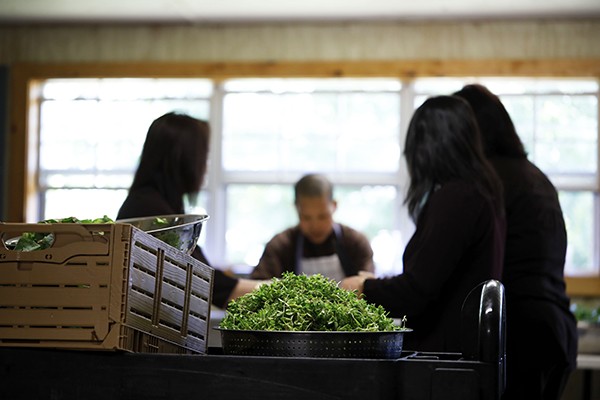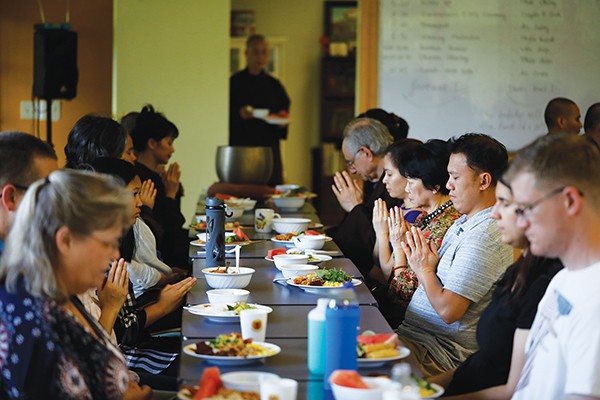One day recently when I was trying to meditate, one of the many whack-a-mole thoughts that popped into my head was, “I wonder what Thich Nhat Hanh would have to say about Ken Burns’ The Vietnam War?”
Thich Nhat Hanh, known as Thay — Vietnamese for teacher — among his fellow practitioners, is a world-revered Vietnamese Zen Master who was exiled from his home country in 1965 for objecting to the Vietnam War.
 Justin Fox Burks
Justin Fox Burks
My thoughts did not stop there. I thought he probably wouldn’t watch it because it’s about killing people and that would contradict two of the five Mindfulness Trainings, what are called the Five Precepts in other Buddhist traditions, the first of which is not to support any kind of killing and the fifth of which is to be mindful of what you consume, including media.
I spent four days at Thich Nhat Hanh’s practice center and monastery in Batesville, Mississippi, Magnolia Grove, in May, and my experience convinced me to attempt to uphold these Five Mindfulness Trainings — reverence for life; practicing true happiness with generosity of mind, speech, and action; practicing true love in my relationships; practicing loving speech and deep listening; and being mindful of what I consume, physically and mentally. (Disclaimer: I am human.)
People, this shit works.
When I returned home, the chronic pain I had been wrestling with for close to five years and for which I had seen eight orthopedists, three physical therapists, and countless other specialists, was just … gone. I won’t attempt to explain it. I had been trying to intellectually cure it for years. I just had to be in a place where I could stop. And be. Every moment, just be.
 Justin Fox Burks
Justin Fox Burks
I quit rushing to finish brushing my teeth. I quit dragging my body around to hurry up and walk to meditate and get that over with so I could rush to lunch so I could gulp some food down my gullet so I could try to go and force myself to take a nap. You get the idea.
Plus, there was a sweetness there. Who can be angry and negative when you are surrounded by monks and nuns laughing and playing with dogs, when each monastic’s smile is distinctly beautiful, when all anyone around you has to offer is love and compassion, when the food is So. Damn. Good. and you are encouraged to delight in Every. Single. Bite?
You’re probably wondering how Thich Nhat Hanh came to set up a monastery in Mississippi.
Valid question. His first monastery and practice center, Plum Village, was established in 1982 in southern France, where he eventually settled after his displacement. In 2000, he set up Deer Park in Escondido, California, and in 2007, Blue Cliff Monastery in Pine Bush, New York.
Perhaps the seed for setting up a Buddhist practice center in the Mid-South was planted several decades ago.
In the mid-1960s, while on one of his many speaking tours in the U.S., Thich Nhat Hanh became friends with Martin Luther King Jr. while both were spreading their messages of nonviolent resistance. King would later nominate Thich Nhat Hanh for the Nobel Peace Prize.
That seed was watered when Thich Nhat Hanh held a Peace Walk in Memphis in 2002.
“At least 2,000 people joined, and the Vietnamese community saw such a large crowd, they developed the aspiration to find a place to make into a Plum Village practice center,” says Magnolia Grove nun Sister Boi Nghiem. “At the time we already had a center in Vermont [which moved to New York] and in California, and we wanted something in the central United States.”
A group of families purchased 120 acres in Mississippi, just south of Sardis and just north of Batesville, and in 2005, Thich Nhat Hanh officially accepted Magnolia Grove as a practice center.
 Justin Fox Burks
Justin Fox Burks
So what exactly is Magnolia Grove Monastery?
An intentional community is a close description. Around 30 monastics live there, where they practice Thich Nhat Hanh’s teachings, mindfulness trainings, and meditation. Every Sunday, they open the center to the community, where anyone can come for the day to meditate, practice mindful walking, mindful eating, listen to dharma talks, engage in dharma discussions, and eat the most wonderful food to ever cross your lips.
“It’s a place for people to come to learn how to live in the present moment and pause from the busy-ness of daily life,” Sister Boi says. “It’s a place to find moments of peace in everything and breathe and a place to get in touch with what is in your heart. It’s a place where you can realize the wonders of life are in the here and now.”
“People really enjoy the serenity and peacefulness of the land,” says Magnolia Grove monk Brother Phap Huy, also called Brother Radiance. “When we ring the big bell at 5 in the morning, people will stop their car and come and just listen. The ringing of the bell is a great way to quiet the mind into a peaceful mind.”
They host various retreats at the monastery throughout the year, such as the one I attended, and visit nearby communities, including Memphis, a couple of times a year to host a Day of Mindfulness.
Speaking of which, on Saturday, October 7th, they will return to Memphis for a Day of Mindfulness at Church of the River, downtown. This one will be a little different, though, as there will be 120 monastics from all four practice centers around the world.
Every other year, more than 100 monastics from Thich Nhat Hanh’s four monasteries travel throughout the U.S. to plant and water seeds of compassion, peace, and mindfulness. This year’s tour is themed Awakening Together. Saturday’s Day of Mindfulness, called “Be Free Where You Are,” will include walking meditation, a dharma talk, a brown bag mindful lunch (the monastics invite the community to bring a vegan lunch if you can), and deep relaxation (think sleep) followed by a Q & A. The Day of Mindfulness is free, but donations are always appreciated. The event will run from 9 a.m. to 4 p.m.
“It’s very rare for people to see 100 monastics in the South,” Sister Boi says. “To come and observe how we walk together and to feel that, you have to come and see it directly.”
The Memphis Day of Mindfulness will be followed by a Day of Mindfulness at Magnolia Grove on Sunday as well as a six-day retreat with the touring monastics at Magnolia Grove, October 10th-15th. Space is limited for this retreat.
 Justin Fox Burks
Justin Fox Burks
Also for the curious observer, on Thursday at the Malco Paradiso, there is a special screening of the documentary Walk with Me, directed by Marc J. Francis and Max Pugh and narrated by Benedict Cumberbatch, which explores the lives of the monastics in Plum Village and what it means to devote their lives to mindfulness. The screening is at 7:30 p.m., but at 6:30, 15 monastics will gather at the fountain near the iBank building for a meet-and-greet and a walking meditation to the theater. Tickets must be purchased in advance. To do so, go here: https://gathr.us/screening/20486.
Thich Nhat Hanh is a peace activist, global spiritual leader, and author who has published more than 100 titles and sold more than three million books in the U.S., including his well-known Peace Is Every Step and The Miracle of Mindfulness. He has established six monasteries and a dozen practice centers around the world with 600 monastics living out his teachings and practicing them with their communities. King described him as “an apostle of peace and nonviolence.”
For more information about Magnolia Grove, Thich Nhat Hanh’s teachings, and a calendar of upcoming events, go to magnoliagrovemonastery.org, or just drive to 123 Towles Road in Batesville on a Sunday. It will change your life. I promise.
“What’s nice about our practice is that we practice with the community,” says Sister Boi. “We’re building community through the purpose of mindfulness, through the art of living peacefully in the present moment.”

 Justin Fox Burks
Justin Fox Burks  Justin Fox Burks
Justin Fox Burks  Justin Fox Burks
Justin Fox Burks  Justin Fox Burks
Justin Fox Burks 

 Bianca Phillips
Bianca Phillips  Justin Fox Burks
Justin Fox Burks 
 Dawn Likens
Dawn Likens 




